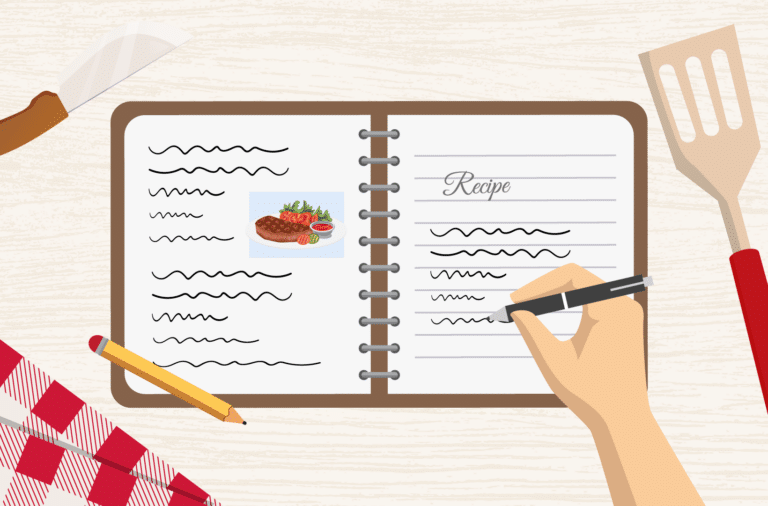Recipe testing is a professional process that ensures recipes are reliable, accessible, and ready for publication. Major food publications, cookbook authors, and test kitchens rely on recipe testers to refine instructions, verify ingredient accuracy, and troubleshoot any issues before a recipe reaches the public. Testers don’t just follow recipes; they analyze them, provide constructive feedback, and help make adjustments that improve clarity, consistency, and overall success.
While some recipe testing opportunities, like America’s Test Kitchen’s volunteer program, start unpaid, professional pathways exist that can lead to full-time careers. If you play your cards well, you could start working with food brands, magazines, or independent authors and play an important role in shaping the recipes home cooks often rely on.
We already have an article on how to test recipes, so this particular guide instead focuses on how you can turn recipe testing into a career. Our seven-step roadmap will help you transition from passionate home cook to professional recipe tester, with actionable advice on gaining experience, building a portfolio, and securing paid opportunities.
| 💬 Don’t have time to read this today? Here’s a TL;DR: 🔹 Start small, think big – Gain experience through volunteer testing programs like America’s Test Kitchen before moving on to paid opportunities. 🎓 Level up your skills – Take online courses in recipe writing, testing methodologies, and documentation to build credibility. 📑 Document everything – Keep detailed testing logs, note modifications, and build a professional portfolio to showcase your expertise. 🧑💻 Build your online presence – A food blog is the best way to highlight your work, and WP Recipe Maker makes it easy to format, optimize, and monetize your tested recipes. 📬 Master outreach – Connect with indie cookbook authors and food bloggers who need testing support, and pitch your services with a strong focus on accuracy and attention to detail. 💰 Diversify income streams – Expand into recipe development, food photography, brand partnerships, and consulting to create multiple revenue sources. 🚀 Turn passion into profit – With the right strategy, recipe testing can grow into a rewarding career – whether through freelancing, food blogging, or working with major publications. |
1. Advance your culinary education through courses
Knowing how to cook is definitely a requisite but it’s not enough to make you a great recipe tester. For that, you need to understand the mechanics of recipe development, standardization, and documentation. Recipe testing requires a methodical approach, including precise measurement techniques, understanding how ingredients interact, and ensuring a recipe is reproducible in any home kitchen.
While formal culinary training isn’t required, structured education can help bridge the gap between home cooking and professional recipe testing. Here are some ways to level up your skills:
- Specialized online courses: Platforms like Food Blogger Pro offer courses on recipe development, including how to test and standardize recipes effectively.
- Test kitchen internships: Gaining hands-on experience in a test kitchen helps refine your ability to assess recipes under real-world conditions.
- Workshops and certifications: Short-term programs in food writing, sensory analysis, and quality assurance can provide valuable insights into the testing process.
Building a strong foundation in recipe structure, food science, and documentation will make you a better tester and increase your credibility when applying for professional opportunities. Even self-directed learning – such as studying cookbook style guides and analyzing published recipes – can go a long way in developing the expertise needed to break into the field.
| 🧑🎓Not sure where to start? Check out our article on the best food blogging courses and jumpstart your career! |
2. Build your experience through thorough practice
The best way to develop professional recipe testing skills is by consistently testing and documenting recipes with a structured approach. Unlike casual cooking, recipe testing requires methodical evaluation, careful note-taking, and a focus on accuracy over personal preference.
To refine your skills, start by systematically documenting your testing process:
- Create detailed testing logs – Record ingredient measurements, cooking times, texture, and flavor outcomes.
- Track modifications and results – Note any adjustments made and how they affect the final dish.
- Build a portfolio of tested recipes – Organize your findings to showcase your ability to test and refine recipes professionally.
Alongside documentation, gaining hands-on experience across different recipe types is essential:
- Test recipes of varying complexity – From simple one-pot meals to intricate baked goods, diversifying your experience prepares you for different testing demands.
- Practice standardized documentation – Use consistent formatting, clear language, and structured notes to maintain a professional testing approach.
- Work with different recipe styles – Understanding various recipe formats (magazine-style, blog-based, instructional video scripts) broadens your expertise.
For those just starting out, America’s Test Kitchen’s volunteer program offers an excellent entry point. It is unpaid, but it provides real-world testing experience and exposure to industry standards. This type of hands-on practice refines your skills and helps build credibility when pursuing paid opportunities.
3. Learn how to be objective
One of the most important skills a recipe tester must develop is objectivity. Unlike personal cooking, where you can tweak recipes to match your taste, professional recipe testing is about ensuring a recipe works as intended for a wide audience. Your job is to assess functionality, not preference.
To maintain a professional approach:
- Follow instructions exactly as written – Resist the urge to adjust measurements or techniques unless instructed. The goal is to verify that the recipe delivers consistent results as written.
- Evaluate clarity and reproducibility – Check if the instructions are easy to follow, logical, and free of ambiguity. Consider whether a home cook of any skill level could replicate the dish successfully.
- Provide constructive, unbiased feedback – Instead of focusing on whether you like the recipe, highlight potential issues such as confusing wording, missing details, or unexpected cooking outcomes.
Objectivity ensures your feedback is valuable, helping recipe developers refine their work without personal bias.
4. Build an online presence and portfolio
Recipe testing is a behind-the-scenes job, but having an established portfolio can set you apart and open doors to professional opportunities. Major food publications and cookbook authors look for testers with a track record of thorough documentation and objective evaluation, and a well-built online presence showcases your expertise.
Take Louiie Victa, for example. She spent nearly two decades cooking in high-end Las Vegas restaurants, including Bazaar Meat by José Andrés, before transitioning into food photography, recipe development, and testing.

Her shift into food media wasn’t instant – she built her portfolio strategically by documenting her work, networking, and seizing opportunities like developing recipes for Anova Culinary and Eater’s cookbook. Looking back on her transition, she emphasizes that small steps in real time make all the difference:
“The journey takes a bunch of small steps that happen in real time. I wish I realized earlier that you don’t need to wait to have all your ducks in a row. You can get them in line as you go.” – Louiie Victa
Her story proves that building a portfolio showcasing your skills and adaptability is key to landing professional opportunities.
Components of an effective recipe testing portfolio
A strong portfolio should demonstrate both your technical accuracy and your ability to evaluate recipes critically. Essential elements include:
- Documentation of testing processes – Showcase your ability to analyze and refine recipes.
- Clear explanations of recipe improvements – Detail what changes were made and why.
- Objective evaluation skills – Show that you can assess a recipe beyond personal preference.
- Experience with different cuisines and techniques – Variety adds credibility to your work.
Why a food blog is the ideal portfolio platform
A food blog is one of the best ways to organize and present your recipe testing work. It allows you to:
✅ Document detailed testing notes in a structured, searchable format.
✅ Showcase recipe writing skills and understanding of formatting.
✅ Demonstrate expertise in food media through recipe development, food photography, and SEO-friendly content.
✅ Create a searchable archive of tested recipes, making it easy for potential employers to review your work.
“Ethics matter – if you’re testing recipes for a company, get permission before posting any tested recipes. Always wait until a recipe is officially published before sharing your notes, and consider focusing on your original recipes to showcase your skills.”
Birthe VandermeerenCofounder of Bootstrapped Ventures
“Ethics matter – if you’re testing recipes for a company, get permission before posting any tested recipes. Always wait until a recipe is officially published before sharing your notes, and consider focusing on your original recipes to showcase your skills.”
Birthe Vandermeeren, Cofounder of Bootstrapped Ventures
WP Recipe Maker: The best tool for showcasing your work

If you’re using a WordPress blog, WP Recipe Maker is the ultimate tool for organizing, formatting, and optimizing your tested recipes. It allows you to:
- Use customizable templates to present recipes professionally.
- List ingredients and nutritional info in a clear, structured way.

- Embed photos and videos to showcase the testing process.
- Enable interactive features like adjustable servings, star ratings, and print-friendly recipe cards.

- Improve SEO automatically, helping your content rank on Google.
With WP Recipe Maker, your portfolio will not only look professional but also make it easier for potential clients to evaluate your expertise.
6. Master the art of outreach: How to connect with publications and kitchens
Breaking into recipe testing requires proactive outreach and strategic networking. While major publications often have established test kitchens, indie cookbook authors, small food blogs, and startup food brands frequently need recipe testers but lack in-house staff. These are your best targets for freelance opportunities.
Craft a targeted outreach strategy
Your outreach should emphasize accuracy, attention to detail, and reliability – qualities that set professional testers apart. When contacting potential clients, be concise and professional. Here’s an example of an outreach email:
| Subject: Experienced Recipe Tester Available for Freelance Work |
| Hi [Recipient’s Name], |
| I’m a detail-oriented recipe tester with [X years] of experience analyzing and refining recipes to ensure clarity, accuracy, and reproducibility. I specialize in [specific cuisine or style] and have worked with [mention relevant experience]. I’d love to offer my services as a recipe tester for your upcoming projects. I focus on providing detailed feedback, structured documentation, and objective evaluations to help ensure your recipes perform flawlessly for home cooks. You can view my portfolio here: [Portfolio Link]. Would you be open to a quick chat about how I can support your work? Looking forward to hearing your thoughts! Best, [Your Name] |
Expand beyond cold outreach
While cold emails can help, networking and collaborations often lead to better opportunities. Consider:
- Connecting with food bloggers – Many need testers to refine their recipes before publishing. Offer to test in exchange for a portfolio credit or testimonial.
- Joining online food communities – Platforms like Facebook groups for food writers or subreddits dedicated to recipe development can be valuable.
- Attending industry events – Food expos, cookbook launches, and virtual panels help you meet potential clients.
Building relationships rather than just applying to job postings gives you a stronger, more sustainable path into professional recipe testing.
7. Diversify skills and income streams
A successful career in recipe testing isn’t just about testing – it’s about expanding your skill set to create multiple revenue streams. Many professional testers evolve into complementary roles, increasing their earning potential and job stability.
Transitioning into recipe development
Recipe testing is a natural stepping stone to recipe development. Many food companies, publishers, and brands seek professionals who can both test and refine recipes. If you already understand what makes a recipe work, you can move into developing new ones tailored to specific audiences.
Food photography and styling
Strong visual documentation can make you more valuable to publishers and brands. Many recipe testers also photograph their results, adding food styling to their skill set. Brands and publications often prefer testers who can provide both written feedback and high-quality images.
📸Love photography? We have a whole collection of food photography guides to help you become the best there is!
- Mastering Food Photography: Secrets and Tricks Revealed
- How to Fix Common Food Photo Issues with These Editing Tips
- 8+ Key Food Photography Props for Any Budget
- Exploring the Key Angles in Food Photography
- Ultimate Camera Guide for Food Photography
- A Comprehensive Guide to Food Photography Lighting Setup
Content creation and brand partnerships
Expanding into content creation can unlock several income streams:
- Cookbook ghostwriting and testing – Work behind the scenes to refine and document recipes for cookbook authors.
- Brand partnerships – Test and review recipes for food brands, helping them perfect their products.
- Food blog revenue – Monetize your website with affiliate links and sponsored content.
🔹 WP Recipe Maker makes this easy by allowing you to add affiliate links for ingredients and equipment directly into your recipe cards.

Consulting for restaurants and food businesses
Many restaurants and food startups need expert testers to refine menu items before launching. Offering consulting services can position you as a trusted expert in recipe accuracy and menu development.
By diversifying your skills, you create more opportunities and income stability – turning recipe testing into a long-term, sustainable career.
Launch your recipe-testing career with confidence
Becoming a professional recipe tester starts with hands-on experience – whether through volunteer programs like America’s Test Kitchen or testing recipes for food bloggers. As you refine your skills and build a portfolio, opportunities with cookbook authors, food brands, and publications become more accessible.
The key to long-term success is diversifying your income streams. Many recipe testers expand into recipe development, food photography, brand partnerships, and consulting, creating a stable career with multiple revenue sources.
WP Recipe Maker is an essential tool for those leveraging food blogging as a platform. It makes recipe formatting a breeze, helps with organic search rankings, and allows for affiliate monetization – helping you turn your blog into a profitable part of your business.
With the right strategy, you can turn recipe testing into a rewarding and sustainable career, combining passion with professional opportunity.







